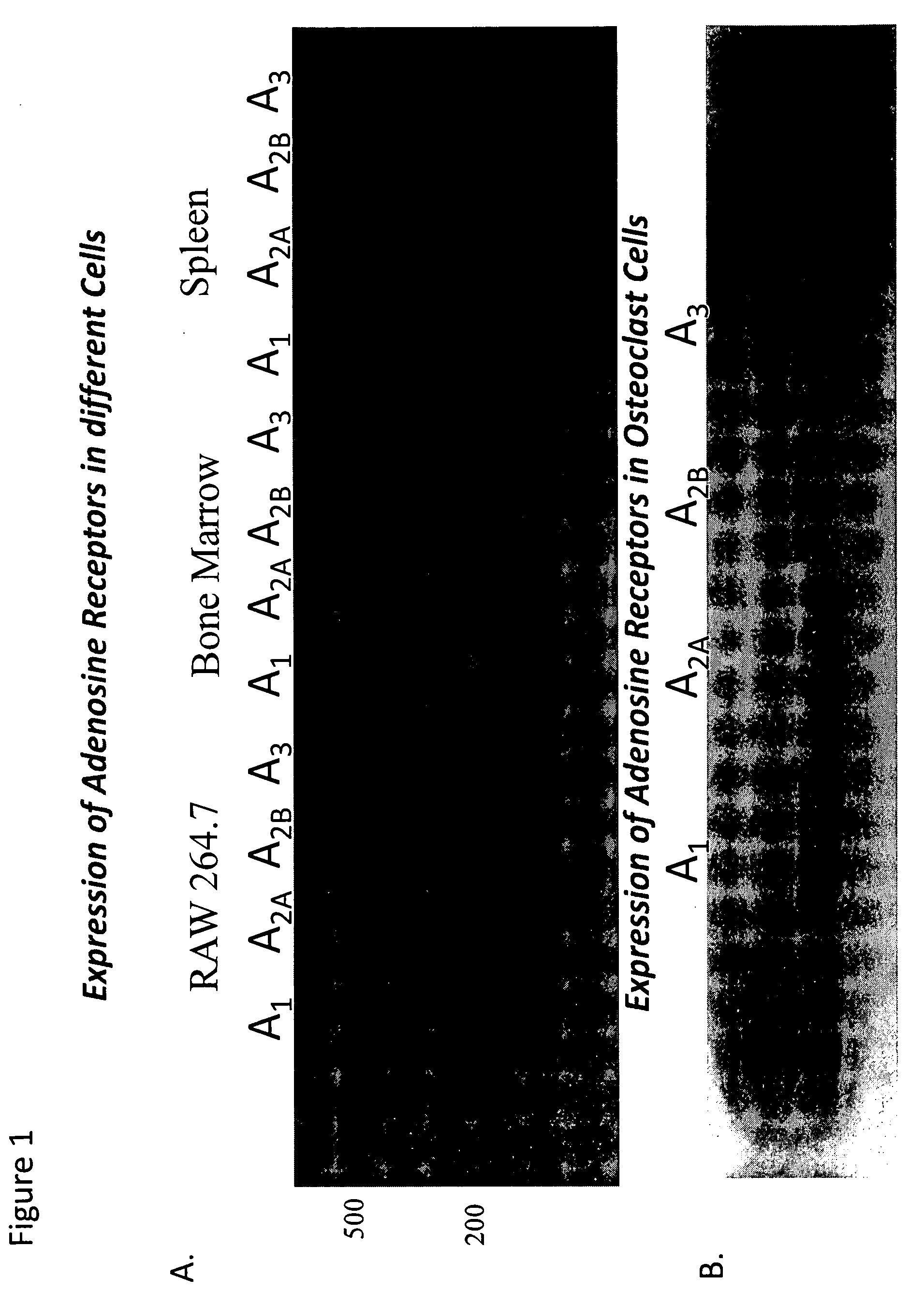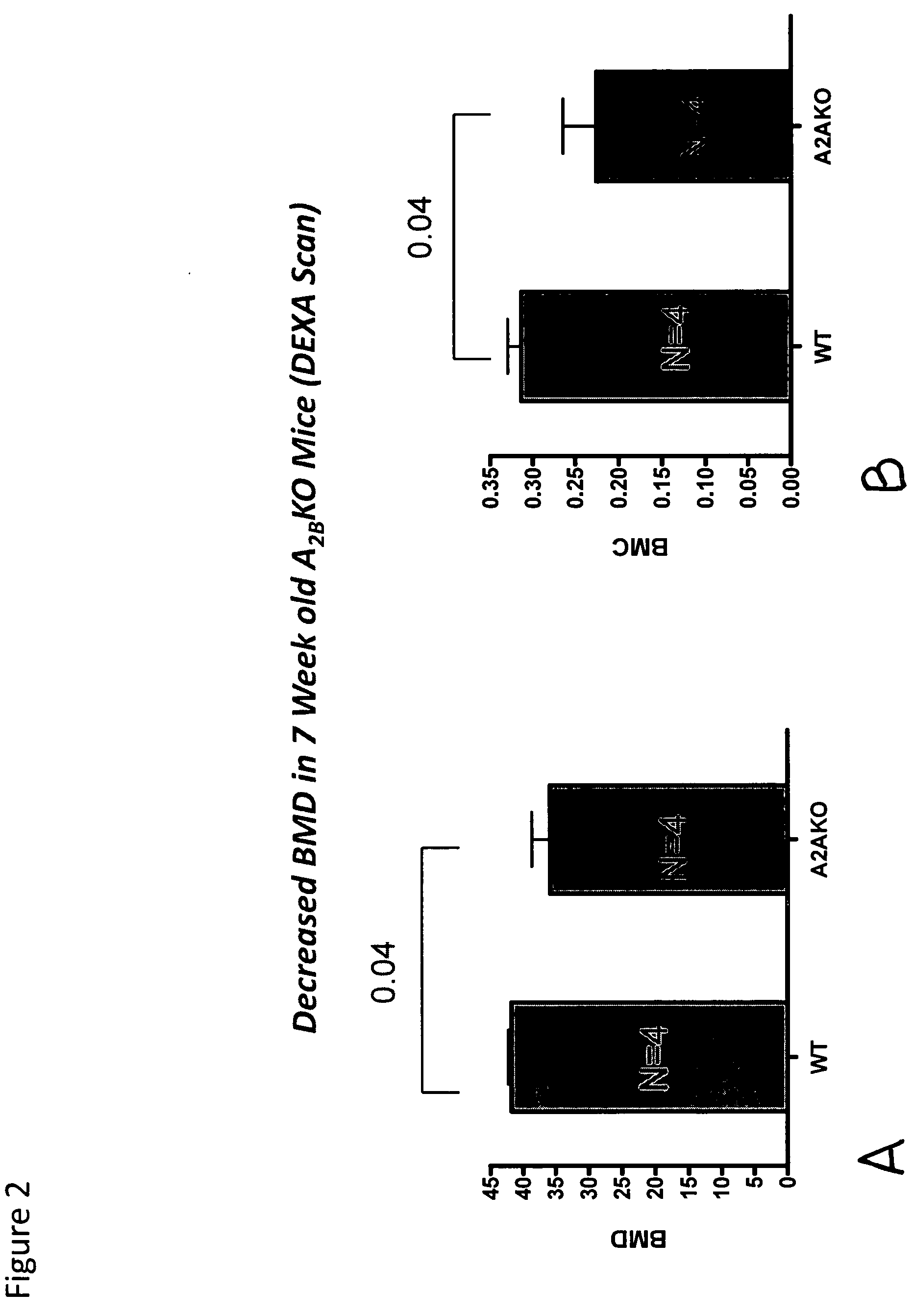Medical implants containing adenosine receptor agonists and methods for inhibiting medical implant loosening
a technology of adenosine receptor and adenosine receptor antagonist, which is applied in the direction of bandages, biocide, drug compositions, etc., can solve the problems of bone resorption and inflammation alone are not sufficient to induce bone resorption, so as to reduce side effects, minimize potential damage to unaffected cells, and increase therapeutic indices
- Summary
- Abstract
- Description
- Claims
- Application Information
AI Technical Summary
Benefits of technology
Problems solved by technology
Method used
Image
Examples
example 1
[0114]Bone mineral density in 6-month old A2A receptor knockout mice and otherwise genetically identical wild type mice was determined. The A2A receptor knockout mice had significantly lower bone mineral density, and examination of their long bones showed increased bone resorption and increased numbers of osteoclasts. Electron microscopy demonstrated that the osteoclasts appeared to be much more active in bone resorption than in the wild type mice. When studied in vitro RAW264.7 cells, a murine cell line, can be induced to differentiate into osteoclast-like cells. Culture of these cells in the presence of an adenosine A2A receptor antagonist inhibited osteoclast formation. Bone mineral density was determined in anesthetized mice by use of quantitative Xray densitometry (DEXA scan, Piximus GE).
Electron Microscopy of Osteoclasts
[0115]Both tibiae and femora of five animals will be fixed in 2.5% glutaraldehyde in 0.1 M sodium cacodylate buffer (pH 7.4) for 12 hours at ambient temperatur...
example 2
[0117]A model of prosthesis loosening and bone resorption will be established. A subcutaneous air pouch will be created on the dorsum of a mouse. Ultra high molecular weight polyethylene debris will be implanted into the air pouch followed by implantation of calvaria from syngeneic mice. The material will be harvested from the mice after 14 days, and bone resorption and inflammation will be assessed. An adenosine A2A receptor agonist (CGS21680) will be mixed into methylmethacrylate glue applied to the calvarial bone in some animals or methylmethacrylate glue alone applied to the calvarial bone in controls. Numbers of TRAP+ osteoclasts, bone resorption (microCT), bone collagen content (von Gieson stain), inflammatory cytokine production (IL-1, TNF, IL-6) in exudates (ELISA) and by FISH in bone will be assessed according to the procedures described by Ren, et al., 2006, Journal of Orthopaedic Research 24:1575-1586.
[0118]Similar preparations in adenosine A2A receptor knockout mice will...
example 3
[0119]Background. Osteoclasts are bone-resorbing, multinucleated giant cells that are essential for bone remodeling and that are formed through the fusion of mononuclear precursor cells. Osteoclasts differentiate from hemopoietic precursors of the monocyte / macrophage lineage in the presence of M-CSF and receptor activator of NF-kB ligand (RANKL). Deficiency of osteoclasts leads to osteopetrosis, a condition characterized by increased bone density. Nonetheless, most bone diseases are due to increased bone resorption by osteoclasts and inhibition of osteoclast-mediated bone resorption is a primary therapeutic objective. Indeed, most current therapies for osteoporosis are directed at inhibition of osteoclast function. Adenosine, a potent endogenous physiological mediator, regulates a wide variety of physiological processes via interaction with one or more of four G protein-coupled receptors (A1, A2A, A2B and A3), expressed on many cell types. Because we have previously reported that ad...
PUM
| Property | Measurement | Unit |
|---|---|---|
| molecular weight | aaaaa | aaaaa |
| molecular weight | aaaaa | aaaaa |
| molecular weight | aaaaa | aaaaa |
Abstract
Description
Claims
Application Information
 Login to View More
Login to View More - R&D
- Intellectual Property
- Life Sciences
- Materials
- Tech Scout
- Unparalleled Data Quality
- Higher Quality Content
- 60% Fewer Hallucinations
Browse by: Latest US Patents, China's latest patents, Technical Efficacy Thesaurus, Application Domain, Technology Topic, Popular Technical Reports.
© 2025 PatSnap. All rights reserved.Legal|Privacy policy|Modern Slavery Act Transparency Statement|Sitemap|About US| Contact US: help@patsnap.com



